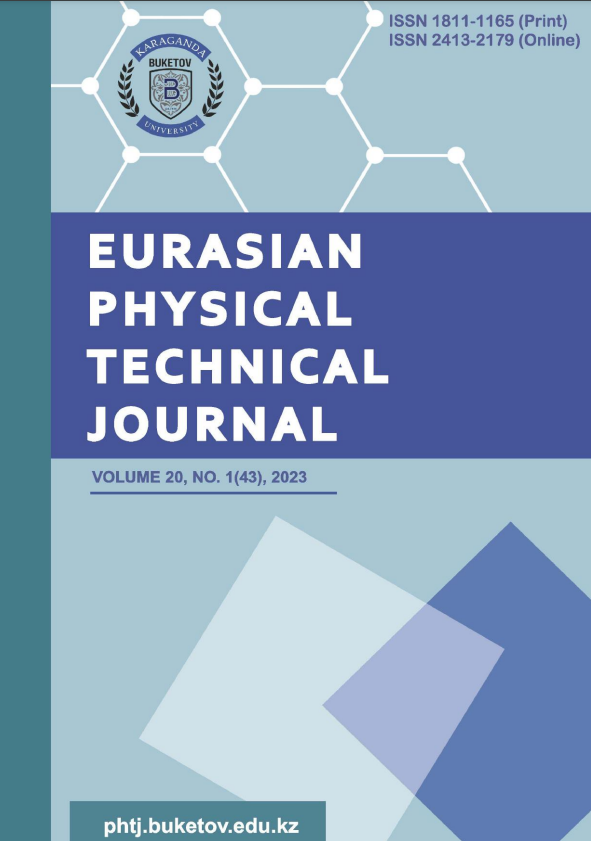Кеуекті толтырғышпен композициялық материалдың қасиеттерін компьютерлік модельдеу
DOI:
https://doi.org/10.31489/2023NO1/56-64Кілт сөздер:
композициялық материал, кеуекті толтырғыш, жылу өткізгіштік, шекті элементтер әдісі, көп қабатты қабықшаАңдатпа
Мақала кеуекті толтырғыштар негізіндегі композициялық материалдардың жылудан қорғайтын және механикалық қасиеттерін болжауға арналған. Гомогенді және гетерогенді құрылымды материалдарының жылу өткізгіштік коэффициенттерін анықтаудың аналитикалық тәуелділіктері келтірілген. Шекті элементтер әдісі негізінде вариатропты құрылымды композициялық материалдарының жылу өткізгіштік коэффициентін сандық анықтау әдістемесі әзірленген. Компьютерлік зерттеулердің нәтижелері аналитикалық модельдерде алынған тәуелділіктермен салыстырылған. Кеуекті толтырғыштар негізіндегі көп қабатты композициялық материалдарды қабықты және пластиналы типті тірек және қоршау конструкцияларында қолданудың орындылығы көрсетілген.
References
Lu J.-X., Shen P., Asad H., Chi A., Poon S. Development of high performance, lightweight concrete using ultra high performance, cementitious composite and different lightweight aggregates. Cement and Concrete Composites, 2021, Vol. 124, No. 104277. doi:10.1016/j.cemconcomp.2021.104277
Mo K.H., Hussein M.N., Ling T.-C., et al. Development of lightweight aggregate mortar skin layer for an innovative sandwich concrete composite. Journal of Building Engineering, 2020, Vol. 27, No. 100941. doi:10.1016/j.jobe.2019.100941
Miryuk O. Porous composite material based on liquid glass. Complex Use of Mineral Resources, 2022, Vol. 323, No. 4, pp. 15 – 22. doi:10.31643/2022/6445.35
Korotkikh А.G. Thermal conductivity of materials, Tomsk, Publishing House of Tomsk Polytechnic University, 2011, 97 p. [in Russian]
Yesbaev A.N., Yessenbayeva G.A., Ramazanov M.I. Investigation of the model for the essentially loaded heat equation. Eurasian Physical Technical Journal. 2019, Vol. 16, No. 1(31), pp. 113-120. doi:10.31489/2019No1/113-120
Zhirov С.Г., Koptelov А.А., Milekhin Yu.М. Thermal conductivity of heterogeneous materials. Part II. Method for calculating thermal conductivity of heterogeneous materials with interpenetrating components. Applied physics, 2005, No. 4. pp. 39 – 43. [in Russian]
Merzadinova G.T., Sakipov K.E., Sharifov D.M., Mirzo A., Bekishev A.Z. Laser photoacoustic method for determining the coefficients of thermal conductivity and thermal conductivity of materials. Eurasian Journal of Physics and Technology, 2019, Vol. 16, No. 1, pp. 94 – 98. http://rep.ksu.kz//handle/data/9344
Sulaberidze V.Sh., Skorniakova E.A. Estimation of Thermal Conductivity Calculation Model Parameters for Composite Materials with a Polymer Binder Based on Experimental Data. Vestnik of Nosov Magnitogorsk State Technical University, 2020, Vol. 18, No. 4, pp. 57 – 64. [in Russian]
Remesar J.C., Simon F., Vera S., Lopez M. Improved balance between compressive strength and thermal conductivity of insulating and structural lightweight concretes for low rise construction. Construction and Building Materials, 2020, Vol. 247, No. 118448. doi:10.1016/j.conbuildmat.2020.118448
Malachanne E., Cassidy R., Garcia-Diaz E., Dubois F. Numerical model for mechanical behavior of lightweight concrete and for the prediction of local stress concentration. Construction and Building Materials, 2014, Vol. 59, pp. 180 – 187. doi:10.1016/j.conbuildmat.2014.01.067
He F., Wang Y., Zheng W., Wu J.-Y., Huang Y.-H. Effective thermal conductivity model of aerogel thermal insulation composite. International Journal of Thermal Sciences, 2022, Vol. 179, No. 107654. doi:10.1016/ j.ijthermalsci.2022.107654
Tian S.-Q., Yu S.-F., Wang X., Fan L.-W., Yu Z.-T., Xu X., Ge J. Experimental determination and fractal modeling of the effective thermal conductivity of autoclave aerated concrete (AAC) impregnated with paraffin for improved thermal storage performance. Applied Thermal Engineering, 2019, Vol. 163, No. 114387. doi:10.1016/j.applthermaleng.2019.114387
Wu X., Wang S., Yang J., Zhao J., Chang X. Damage characteristics and constitutive model of lightweight shale ceramsite concrete under static-dynamic loading. Engineering Fracture Mechanics, 2022, Vol. 259, No. 108137. doi:10.1016/j.engfracmech.2021.108137
Wang Y., Ma C., Liu Y., et al. A model for the effective thermal conductivity of moist porous building materials based on fractal theory. International Journal of Heat and Mass Transfer, 2018, Vol. 125, pp. 387 – 399.
doi:10.1016/j.ijheatmasstransfer.2018.04.063
Song G., Wang L., Deng L., Yin H.M. Mechanical characterization and inclusion, based boundary element modeling of lightweight concrete containing foam particles. Mechanics of Materials, 2015, Vol. 91, pp. 208 – 225. doi:10.1016/j.mechmat.2015.07.014
Galkin A., Zheleznyak M., Zhirkov A. Increasing thermal stability of the roads in cryolithic zone. Transportation Research Procedia, 2022, Vol. 63, pp. 412– 419. doi:10.1016/j.trpro.2022.06.029
Xu J.Z., Gao B.Z., Kang F.Y A Reconstruction of Maxwell Model for Effective Thermal Conductivity of Composite Materials. Applied Thermal Engineering, 2016, Vol. 102. No. 6, pp. 972 – 979. doi:10.1016/j.applthermaleng.2016.03.155
Quan W.,Ma X.,Li X.,Dong Z. Efficient numerical model for effective thermal conductivity of concrete with aggregates of different morphologies and imperfect interfaces. International Journal of Heat and Mass Transfer, 2022, Vol. 185, No. 122358. doi:10.1016/j.ijheatmasstransfer.2021.122358
RenY., Yu Z., Huang Q., Ren Z. Constitutive model and failure criterions for lightweight aggregate concrete: A true triaxial experimental test. Construction and Building Materials, 2018, Vol. 171, pp. 759 – 769. doi:10.1016/j.conbuildmat.2018.03.219
Sadrmomtazi A., Sobhani J., Mirgozar M.A. Modeling compressive strength of EPS lightweight concrete using regression, neural network and ANFIS. Construction and Building Materials, 2013, Vol. 42, pp. 205 – 216. https://doi.org/10.1016/j.conbuildmat.2013.01.016
Sun X., Liao W., Kumar A., et al. Multi-level modeling of thermal behavior of phase change material incorporated lightweight aggregate and concrete. Cement and Concrete Composites, 2021, Vol. 122, No. 104131. doi:10.1016/j.cemconcomp.2021.104131
Elshahawi M., Hückler A., Schleich M. Constitutive relations and finite element modeling of Infra Lightweight Concrete (ILC). Journal of Building Engineering, 2022, Vol. 48, No. 103869. doi:10.1016/ j.jobe.2021.103869
Mishra R., Behera B.K., Muller M., Petru M. Finite element modeling based thermodynamic simulation of aerogel embedded nonwoven thermal insulation material. International Journal of Thermal Sciences, 2021, Vol. 164, No. 106898. doi:10.1016/j.ijthermalsci.2021.106898
Miryuk O., Fediuk R., Amran M. Foam Glass Crystalline Granular Material from a Polymineral Raw Mix. Crystals, 2021, Vol. 11, No. 1447. doi:10.3390/cryst11121447
Miryuk O. Liquid-glass concrete of variable density. IOP Conference Series: Materials Science and Engineering, 2020, Vol. 869, No. 032025. doi:10.1088/1757-899X/869/3/032025
Miryuk O., Fediuk R., Amran M. Porous Fly Ash /Aluminosilicate Microspheres-Based Composites Containing Lightweight Granules Using Liquid Glass as Binder. Polymers, 2022, Vol. 14(17), No. 3461. doi:10.3390/polym14173461













